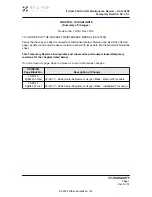
EN
07
06
Brake Lines
The brake line lengths have been set carefully during testing. We feel it is better to have
slightly long brake lines and to fly with a wrap when necessary.
•
Ensure both main brake lines are of equal length.
•
If a brake handle has been removed, check that its line is still routed through the pulley
when it is replaced.
•
When the brake handles are released in flight, the brake lines should be slack. There
must be a substantial “bow” in them to guarantee no deformation of the trailing edge.
•
There must be a minimum of 10cm of free play before the brakes begin to deform the
trailing edge. This prevents the trailing edge from being deformed when using the speed
system or when controlling the wing with the TST.
Adjustable Brake Pulley Position
The height of the brake line pulley can be adjusted according to pilot preference and to suite
the power unit’s hang points height. Higher settings are for low hang point motors whilst a
middle or lower setting are for units with higher hang points.
To adjust the pulley height, first remove them from the risers and re-attach at the desired
position, then undo the Velcro magnet attachments and re-attach a few cms below the new
pulley position. If you lower the pulley height, you must also lengthen the brake lines and TST
lines accordingly. Moving the pulleys to the middle position on the risers requires the addition
of about 10cm to the overall brake/TST line lengths (measured from the mark on the lines).
Moving to the lowest position requires an additional 20cm from the marks.
Tip Steering System
The Tip Steering System (TST) uses ergonomic handles for control of the wing during
accelerated flight. Located on the B risers, the handles are easily accessible and linked to the
very tips of the wing, giving high levels of precision and comfort for high speed cruising or
accurate low level carving. The TST allows for precise handling without the need to use the
brakes, it is not necessary to use large control movements to effect a turn so be progressive
and gentle at first until you are familiar with the handling characteristics. The attachment
height of the TST handles can also be adjusted according to your comfort, flying style and
motor unit.
For directional control whilst flying with the speed bar only use the TST. DO NOT use the brakes
alone. Application of brake when the wing is at a low angle of attack has a negative effect on
the reflex profile causing loss of precision, adverse roll, and reduced collapse resistance. In
accelerated flight the tip steering system can be used for both directional control - to keep a
straight heading and for effecting nice smooth turns. It becomes more precise the faster you
fly.
When using the TST, it is advised to keep the brake handles through the wrists. This is in case
of an engine failure or loss of control. It is therefore necessary to ensure that the brake lines
are adjusted in such a way that they are not activated when using the tip steering - make sure
the brake and TST lines are set correctly.
2D Steering System
The optional 2D system has been developed for competition slalom racing where precise
control of the trailing edge is absolutely necessary. The 2D system combines the brake lines
and the TST so that the tip lines (TST) alone can be engaged, or only the brakes in the middle
part of the wing engaged, or a combination of both.
The 2D system can be set up and adjusted according to your personal preference, flying
style and power unit hang point heights. The lower the brake pulley position on the risers the
more effective the 2D steering system becomes, however the standard setting, as described
below, is a good starting point for low hang point power units and a good compromise between
comfort and ease of use.
Pushing the handle away from your body engages the brakes in the middle of the trailing
edge (Scheme 1), whilst pulling the hand close towards your body will engage the wing tips
(Scheme 2). Pulling the brakes down in the normal manner will engage both the TST and the
brakes (Scheme 3).
IMPORTANT
In the unlikely
event of a brake line
snapping in flight, or
a handle becoming
detached, the glider
can be flown by gently
pulling the rear risers
(D-risers), or the TST
for directional control.
IMPORTANT
If you adjust the
brake pulley height,
you MUST re lengthen
the brake lines
accordingly.
IMPORTANT
When accelerated
directional control
should be maintained
with the TST system or
the Tube Ball handle
(if the 2D system is
installed). Do NOT use
the brakes.
Содержание Speedster 2
Страница 1: ...Pilots Manual...
Страница 2: ......
Страница 20: ...1258 Route de Grasse Le Bar sur Loup 06620 France...






































